Your home, like a car, requires regular care and maintenance to make sure that all of it’s systems are functioning properly and running at peak performance. Preventative maintenance will extend the life of those systems and save you money from month to month.
The long Austin summers can be especially harsh on your house, with the Central Texas area averaging 4 months of 90+ degree weather. There are several quick, inexpensive ways to help prepare your home for the summer months ahead. Give your home some love with these 7 summer maintenance tips:
1. Add Window Treatments – Don’t have money to invest in new windows? Not to worry. Adding window treatments, blinds, or solar screens are an easy and less expensive way to tackle the same problem. Make sure to add these on windows that receive direct sunlight, especially during the afternoon hours. This will limit the penetration of harsh UV rays into your home that naturally heats your conditioned space. Bonus: This will also help cut down on your summer AC bills.
2. Monitor your AC Condenser Unit Fins – Your AC may have one or multiple exterior units, depending on the size of your home. To improve the overall airflow of your condensing unit, it is recommended that you keep these vertical coil fins located on the sides of your condensing unit clean and clear. If you routinely spray the AC fins with a typical garden hose (hose end sprayer attachments are recommended) while the unit is off, you can help eliminate the common dust/debris collection that the coil fins often collect. An HVAC specialist can also improve the condition of the coil fins if you have suffered any damage from possible hail or debris from the lawn equipment. Most condensing unit manufacturers also recommend adequate spacing from all foliage and/or other obstructions (fence, walls, other units, belongings) to help improve the overall efficiency of your HVAC system(s). This spacing is typically 18-24 inches on the sides and 4 feet from the top of the condensing unit.
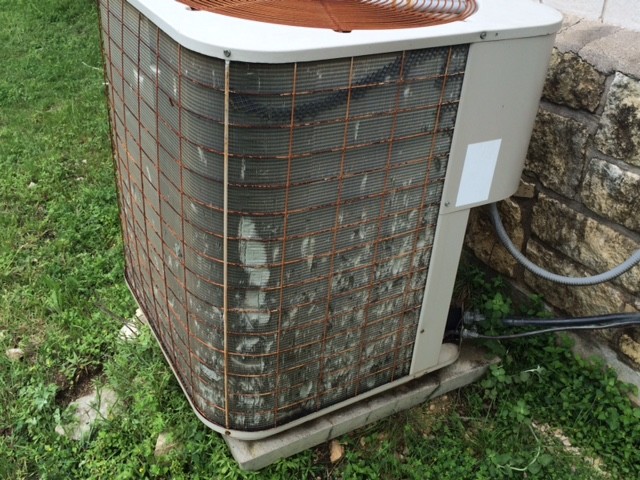
Damaged AC condenser fins
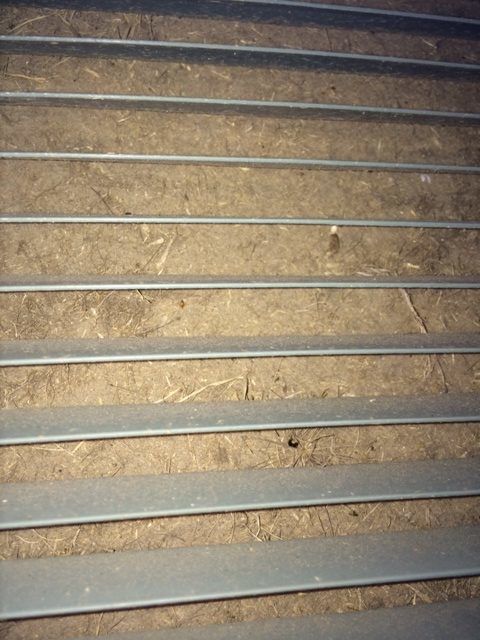
Clogged AC Condesner Fins
3. Monitor Exterior Doors for Efficiency– As you are doing simple chores around the home, it is always recommended that you monitor all of the exterior doors and attic entry doors in the home for proper weatherstripping and insulation where needed. If you can visibly see any light shining through the exterior door’s edges from the interior, you should add weatherstripping in these select areas to help eliminate any unconditioned air from intruding into the home and stressing the overall HVAC system over time. If you have these areas of missing and/or damaged weatherstripping on multiple doors around the home, you are most likely losing conditioned air from the home everyday. The attic entry doors (located in the conditioned areas of the home) should also be checked for proper weatherstripping and insulation to limit the overall loss of condition air from the home and/or intrusion of non-conditioned air into the home. As most Central Texas attics can reach temperatures over 130 degrees in the summers, the weatherstripping and insulation on the attic doors can help increase your overall efficiency for the home and your HVAC system(s). Adding foam insulation panels on your garage door panels will also help improve the overall efficiency of your home as they are typically made of aluminum which will conduct heat and/or cool during the year.
4. Insulate your HVAC Refrigerant Line – Your HVAC system has a refrigerant line that runs from the indoor air handler to the outside condensing unit. As this line travels through attic space and exterior areas, it should have proper foam insulation on the full run to help improve the overall efficiency of the home and condensation drips in the attic areas. This will need periodical replacement as our UV rays will accelerate the deterioration rates of the foam over time. This foam insulation can be purchased at your local hardware store and cut to desirable lengths as needed. It is recommended that you spend a few more dollars to purchase the thicker and longer life expectancy foam insulation for better performance and longevity.
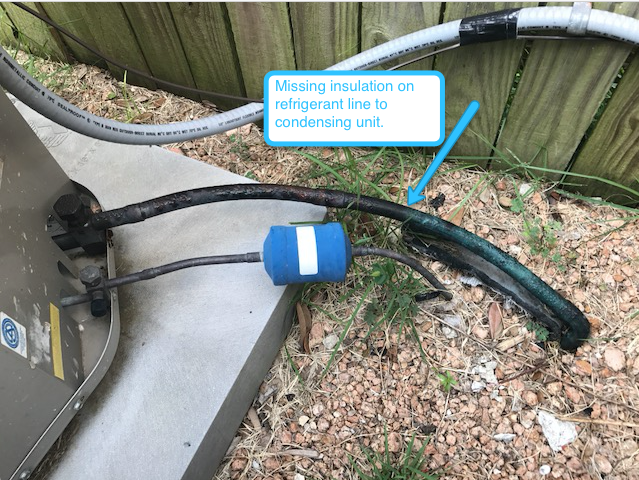
Missing refrigerant
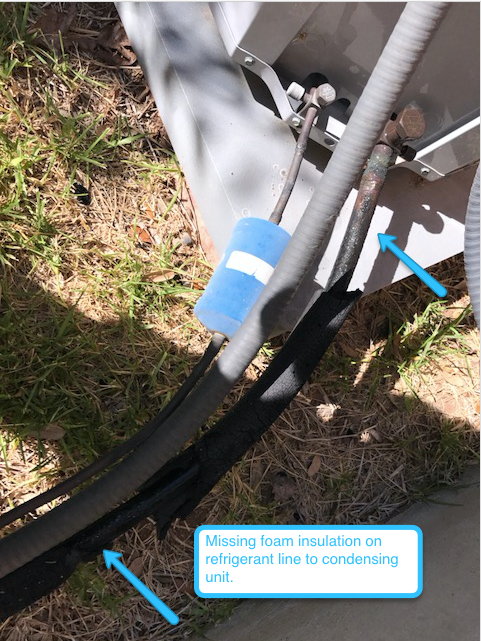
Missing refrigerant line
5. Self-Service your AC System – All air conditioning systems condensate during operation, even our vehicles drip under the car while we are running our air conditioners. In homes, there are different ways that the condensation exits the home safely to avoid possible water damage. The most common way that this is installed is through a primary condensate drain line that runs from the air handler, located inside the home. This is typically routed either to bathroom sink drain piping inside the home or to the exterior of the home using gravity flow. This dripping flow of condensation through a 1” PVC pipe over time can eventually clog inside the piping causing backup issues and possible water damage inside the home. To help avoid this issue, you can provide a hot water and bleach (vinegar if desired) mixture to the upper vertical opening of the primary condensate drain line located near or on your air handler in the home (typically attic or interior closet location). It is recommended that this service be performed 3-4 times a year with 2 of those services in the summer months as we are running the air conditioning systems more frequently. If your primary condensate drain line is routed to the exterior area of the home, be sure to place a bucket at the end of the line to keep from contaminating the grounds.
Additional Note:Insulating of your primary condensate drain line is now required under our current building standards. If your primary condensate drain line travels through your attic or wall cavities, insulating will help avoid condensation dripping on the outer surface of the PVC piping and causing possible water staining on the interior walls and/or ceilings over time.
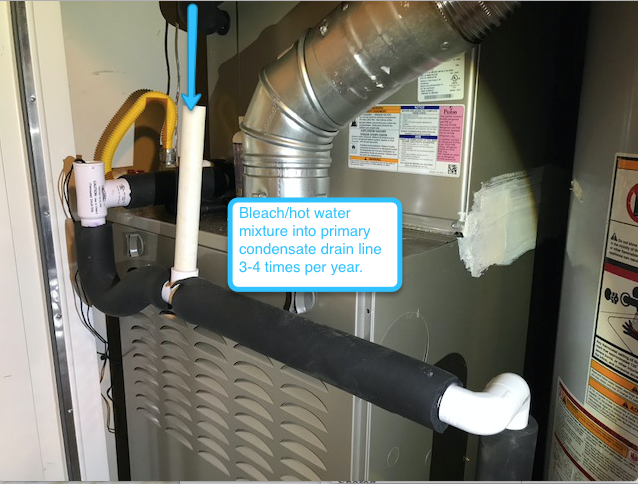
bleach
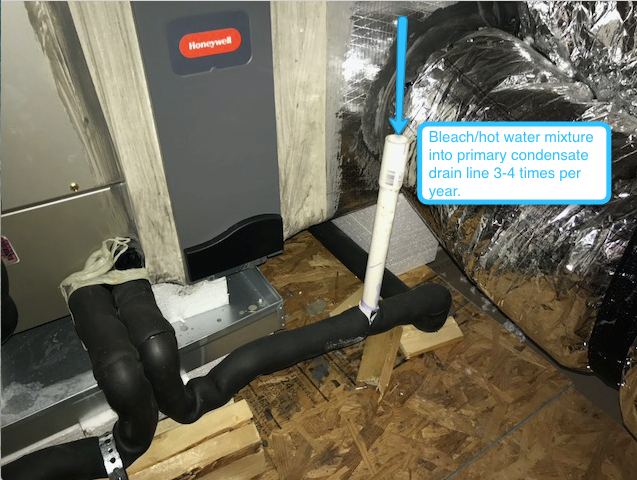
Bleach service
6. Increase Attic Insulation Levels & Ventilation – Increasing the attic insulation levels and ventilation in the attic are also very important to increasing the overall efficiency of the home. This will help decrease the overall heat load in the attic which is located above our conditioned space and help maintain lower temperatures of the conditioned air that travels through the air ducts in the attic that supply the home through to the supply registers. If you have an older home, it is also important to upgrade your air ducts in the home as they are are increasingly more efficient than older ducts systems (added insulation).
7. Energy Audit – To help improve the overall efficiency of your home, save money and energy, and improve the overall indoor air quality you can arrange for an energy audit performed by a City of Austin specialist. This also improves the quality of our everyday lives and increases the overall value of the home.
As home inspectors, we inspect hundreds of homes each year. The majority of deficiencies that we find are related to deferred maintenance by the current occupant. Small, routine maintenance can make a big difference in protecting your big investment.